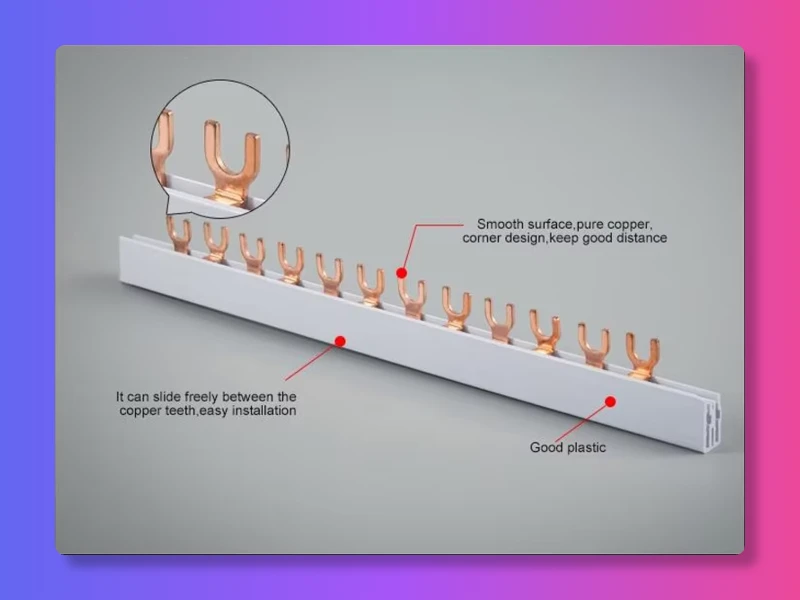Le sbarre a forcella e le sbarre a spinotto sono componenti essenziali dei sistemi di distribuzione dell'energia elettrica e offrono vantaggi unici in termini di design, conduttività e installazione per le diverse applicazioni.
Design delle sbarre a forcella
Barre a forcellaI terminali, noti anche come terminali a forcella, sono caratterizzati da una caratteristica forma a forcella che consente di collegare e scollegare facilmente i terminali. Questo design offre diversi vantaggi:
- Collegamenti sicuri, che riducono il rischio di guasti elettrici.
- Scollegamento e ricollegamento rapidi senza rimuovere l'intero terminale.
- Eccellente conduttività e affidabilità nei sistemi elettrici.
- La struttura robusta li rende adatti a macchinari da costruzione e a dispositivi elettrici pesanti.
- Organizzava i sistemi di cablaggio, riducendo al minimo il disordine e migliorando la sicurezza nei quadri elettrici e di distribuzione.
Il design a forcella di queste sbarre contribuisce alla loro versatilità ed efficienza in varie applicazioni elettriche, in particolare quando sono richiesti due terminali di ingresso.
Design delle sbarre di tipo Pin
Barre di tipo pin sono caratterizzate da una struttura a palo che consente il collegamento tramite pin, offrendo un design compatto e versatile. Queste sbarre possono essere personalizzate in lunghezza per adattarsi a varie applicazioni, rendendole ideali per installazioni personalizzate o con limiti di spazio. Le caratteristiche principali delle sbarre di tipo pin includono:
- Di natura compatta, è adatto alle scatole di alimentazione a bassa tensione e alle scatole illuminate.
- Lunghezza personalizzabile per una maggiore flessibilità nelle diverse applicazioni.
- Gestione efficiente dei carichi elettrici riducendo al minimo le perdite di energia.
- La bassa resistenza di contatto garantisce una buona conduttività.
- Ideale per gli interruttori e le installazioni elettriche essenziali in cui l'ottimizzazione dello spazio è fondamentale.
Il design a palo delle sbarre di tipo pin contribuisce alla loro facilità di installazione e alla loro adattabilità in vari sistemi elettrici, in particolare in ambienti in cui l'efficienza dello spazio è una priorità.
Confronto della conduttività delle sbarre
Se si confronta la conduttività delle sbarre a forcella e di quelle a spinotto, si nota che entrambe hanno prestazioni elevate, ma ci sono delle sottili differenze. Le sbarre a forcella sono rinomate per la loro eccellente conduttività, che garantisce connessioni affidabili e sicure nei sistemi elettrici. Il loro design contribuisce a mantenere una connessione sicura, riducendo il rischio di guasti elettrici e migliorando l'affidabilità del sistema. D'altra parte, anche le sbarre di tipo pin offrono una buona conduttività con una bassa resistenza di contatto, gestendo in modo efficiente i carichi elettrici e riducendo al minimo le perdite di energia. Il loro design compatto favorisce una distribuzione efficiente dell'energia in ambienti con limiti di spazio.
Applicazioni e installazione
Le sbarre a forcella eccellono nelle macchine da costruzione e nei dispositivi elettrici pesanti grazie alla loro robustezza e affidabilità. Il loro design facilita il cablaggio organizzato nei quadri elettrici e di distribuzione, aumentando la sicurezza e riducendo l'ingombro. Le sbarre di tipo pin, invece, sono ampiamente utilizzate negli interruttori automatici, nelle scatole di alimentazione a bassa tensione e nelle scatole luminose, dove l'ottimizzazione dello spazio è fondamentale. Dal punto di vista dell'installazione, le sbarre di tipo pin offrono in genere un'installazione più rapida e semplice, rendendole adatte a installazioni personalizzate o con limiti di spazio, mentre le opzioni di tipo fork, pur essendo semplici da installare, possono richiedere più spazio.




